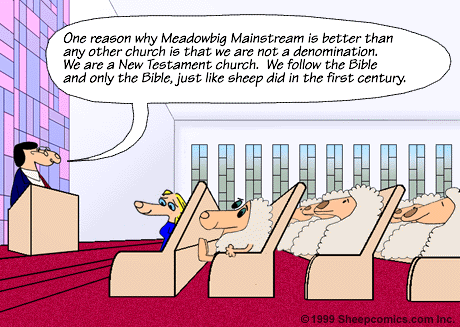
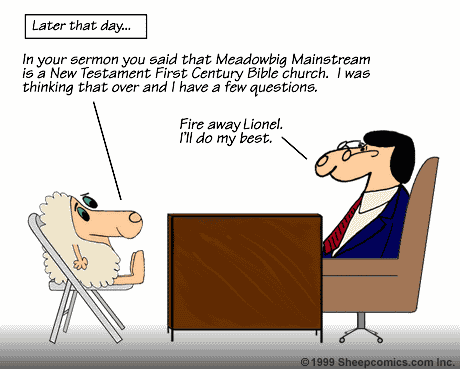
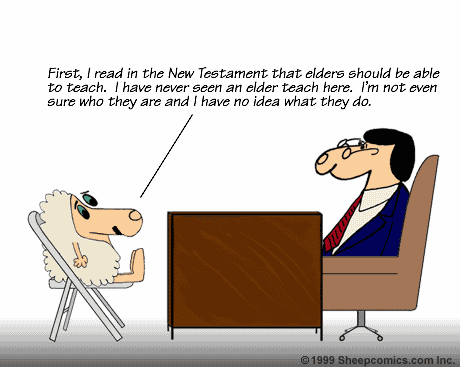
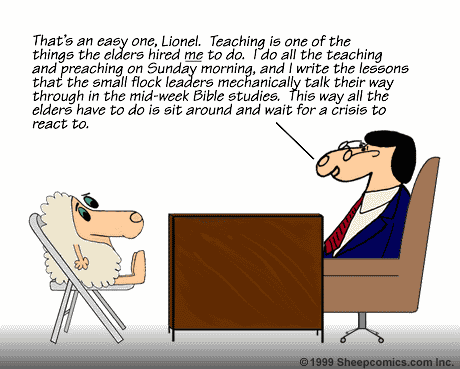
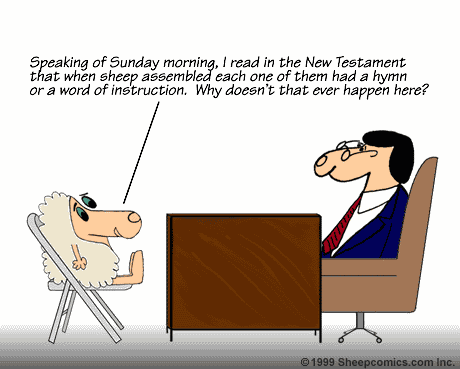
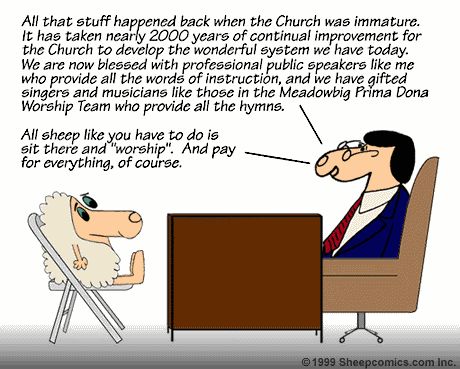
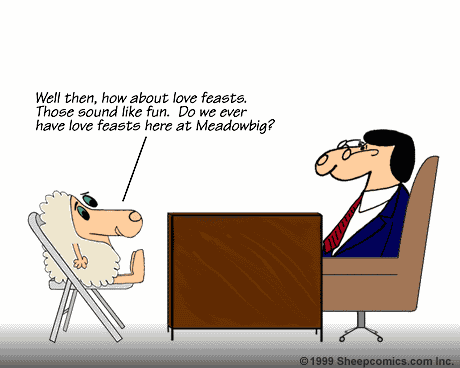
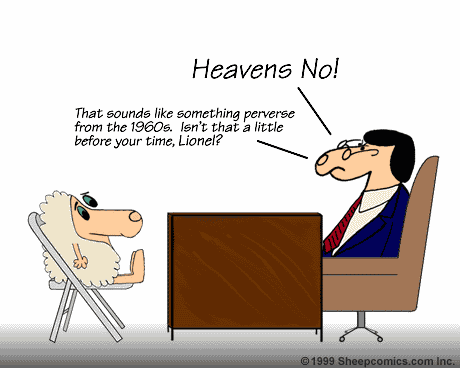
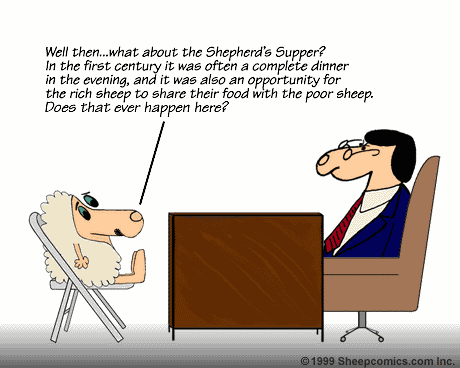
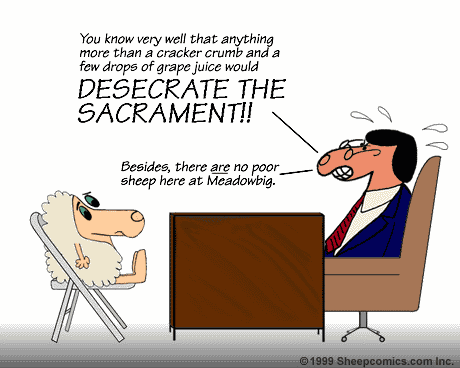
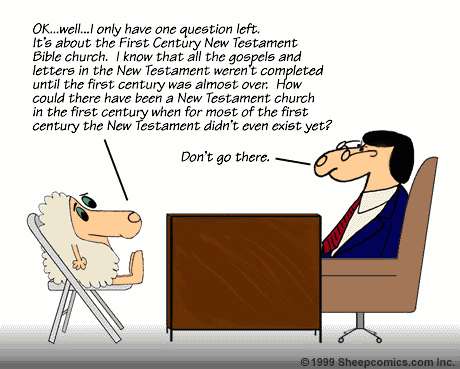
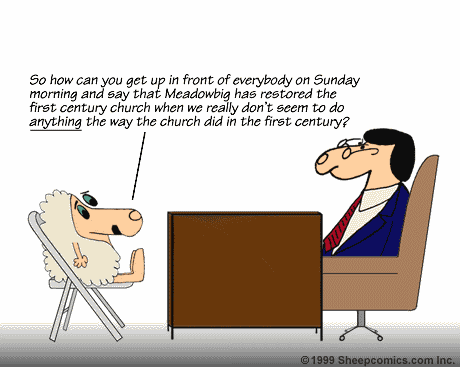
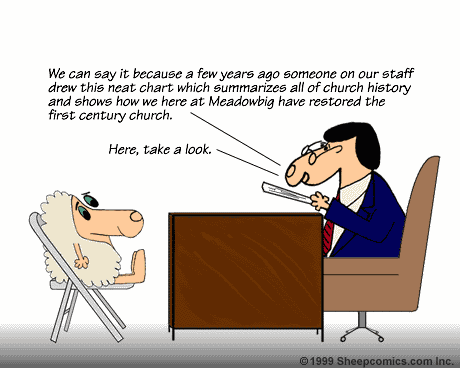
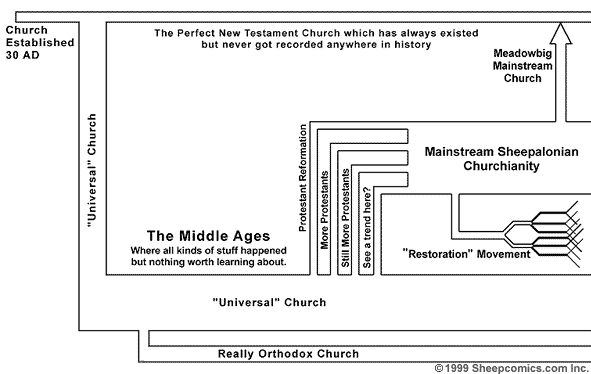


Editorial Notes
I first came to believe in Jesus and in the authority of the Bible when I was a teen. I became "confirmed" in a Protestant denomination, but later left traditional Protestantism and joined a "restoration movement" church in my early twenties. To put it another way, I "accepted Jesus" during my teens in a Protestant setting and was baptized in my early twenties in a "restorationist" setting. I have spent all my adult Christian life among churches whose doctrinal lineage is summarized by the term "restoration movement".
Those of you who are part of one of these groups of churches, or are familiar with the history of Christianity in America, know what I am referring to. To those who donít, I will explain it in the most generic terms possible. Sometime back in the first half of the nineteenth century, religious leaders arose in America who decided that denominational Christianity was a tragically wrong, and that Christianity needed to be unified again.
The way to unify all the different denominations was to "restore" the Christian church of the first century AD Back then, all the individual Christian churches were unified under the leadership of the Apostles. There were no "Lutherans", or "Presbyterians", etc., only "Christians". By getting rid of all the man-made creeds and traditions, we could bring back the holiness and effectiveness of the Christian church we read about in the book of Acts. In fact, the book of Acts became the primary source of determining what the first century church was like, since it is the book in the New Testament that records historical events which occurred after the resurrection of Christ.
It wasnít long before tensions arose between those who stressed inter-denominational unity and those who stressed accuracy in restoring the first century church. Among those stressing Biblical accuracy, there arose disagreements concerning what kinds of worship procedures and ministries are authorized by the New Testament and which are not. To make a long story short, today there are a number of different groups of churches claiming to have "restored" first century Christianity, all tracing their lineage back to a group of leaders from the Nineteenth century.
This claim to have restored "first century" Christianity is not limited to the groups of churches I described above. Within the last few years I have visited two very large churches, one I would most accurately describe as "evangelical mainstream", the other as "mildly charismatic mainstream" and heard leaders at both claiming that they practiced "New Testament" or "Biblical" Christianity. Being "non-denominational" implies doctrinal purity. Claiming to have restored "New Testament Christianity" seems to have become somewhat of a fad.
When Histories Collide
I was quite a believer in "restorationism" at one time in the past, but then two things happened which have quite thoroughly undermined my belief in this concept. first, I spent almost a decade in a church which claimed to have restored first century Christianity. Second, I studied the Bible and church history. My history and church history collided, and my faith in "restorationism" was crumpled up between the two. Below are a few of my recollections from my personal "church history", and some observations from my studies of the Bible and real church history.
What I Learned about Elders
Paul wrote in 1 Timothy 3:2 that an elder should be able to teach. I assume that meant in the first century that elders were expected to teach in the churches. In "restoration" churches, you learn that "first century" churches were led by elders and that each congregation was autonomous. Elder leadership is the first century pattern. I was taught that idea of "Bishops" controlling geographic territories of churches is a man made authority structure.
I donít remember an elder teaching at any time during the almost ten years I faithfully attended a "restoration" church. That doesnít mean it never happened; I just donít remember it. I remember professional staff teaching. I remember preacher interns teaching. (Interns were men usually in their early 20ís right out of college who lived off "support" money while they learned how to be "professional Christians.") I donít remember elders teaching. In fact, I even remember asking a man who had recently become an elder when he was going to teach. He said something like "Thatís not my job." and told me that teaching is the job of the professional "evangelist".
In fact, elders didnít seem to be very visible at all on a week-to-week basis. You found out who the elders were was when something really bad happened, like the rare occasion when someone was disfellowshipped. Elders became temporarily visible during crisis situations and then faded into the background again.
On a personal level, I remember periodically getting form letters from the elders giving me advance notice that I had been selected to help serve the Lordís Supper. The letters said that I should dress appropriately and that if I was spiritually unable to serve in this capacity I should let them know so they could find a replacement. I remember thinking that anyone spiritually unable to pass plates of crackers and trays of communion cups needs an elders help, not simply to be rotated out of the ritual performance schedule. One event I never experienced in ten years was an elder inviting me to his house for lunch or dinner, or even just calling me on the phone to ask how I was doing.
What I Learned about Teaching
In the first century, the ability to teach seemed to be one of those gifts that was distributed throughout the church. In Acts 13:1, Luke states that in the church in Antioch there were prophets and teachers. We have already seen that one of the requirements for eldership is the ability to teach. In Colossians 3:16, Paul writes to a church and says they should "teach and admonish one another in all wisdom" (NRSV). The writer of the book of Hebrews expressed disappointment that all his readers were not teachers (Hebrews 5:12).
In todayís "first century" church, teaching is an area where if you want a job done right you hire a professional. All the teaching I remember occurring on Sunday (except for Sunday-school) was performed by men who were paid to be there. The most important teaching, that occurring during the "worship service",was performed by the "evangelist". (In Ephesians 4:11, "evangelism" was a gift from God, now it is often a corporate title for the professional-in-charge. Under this system, there can be only one per church corporation.) I don't remember the "evangelist" ever being seen listening to a sermon by someone who reported to him. The only time I saw the "evangelist" listening to a sermon was if a super celebrity professional was visiting. The adult classes before the "worship service" were taught either by junior staff professionals or intern professionals. (The difference between a "staff" professional and an "intern" professional is that the "intern" got his money directly from individuals while the "staff" got his money out of the church budget.)
Midweek bible study groups worked differently, at least for a while. To my knowledge, all elders and professional staff lead mid-week bible studies. A lot of "amateurs" led mid-week bible studies too. I was one of those "amateurs". I remember how challenging this was at first. I studied the Bible as I had never studied before because I felt this awesome responsibility to teach accurately. I gained insights at a tremendous rate because I was "learning for others" and not just for myself. In addition, I had to keep in mind the needs and personalities of those I was presenting to. I had to make the Bible relevant, not just present it accurately. I spent several months presenting Bible studies, leading discussions, taking constructive criticism, and trying to do better next week. I was growing as a teacher very quickly.
Of course, this was too good to last. One day the "evangelist" called a meeting of all the mid-week bible-study leaders and announced that henceforth all mid-week bible studies would be written by one of his staff. It was important that there be no "renegade" bible-study groups. Each study leader was to pick up a copy of "this weeks study" after church on Sunday, listen to the instruction tape that came with it, and present the pre-written bible study.
One supposed benefit of this approach was that if each bible-study group was reading off the same page, people would talk about the material more on their own time. What really happened seemed to be the opposite. Before the studies were centrally controlled, some people would go to more than one each week. Also, since different studies were covering different material, people would tell each other about them and "compare notes" so to speak. After central control was imposed, everything was the same for everybody. There was no reason to go to more than one study each week, and people didnít seem to talk about them nearly as much.
I went from being a rapidly growing teacher to being a drone who went through the motions of presenting pre-written material each week. It wasnít fun or exciting anymore. It was a job, not an adventure. I wondered how the professional in his office at the church building knew better than I did what those in my group needed to learn. I also wondered why the "evangelist" decided he couldnít trust non-professionals, who seemed very committed to the congregation and their role as small group leaders, to create teaching material. Finally, I resented the fact that something I found so challenging and exciting was taken away from me by someone whose salary I was still expected to pay. Itís like I had to pay someone to keep me from growing.
What I Learned about the Assembly
In "restoration" churches, we are told that doctrine is determined by commands and examples in the New Testament. For example, in Acts 20:7 we have the example of a church in Troas meeting on the first day of the week to "break bread". We "know" that the term "break bread" means "The Lordís Supper", so this recorded event becomes a law which states that we must observe the Lordís Supper every Sunday. Another command is found in 1 Corinthians 16:2, where Paul tells the church in Corinth to set aside money on the first day of the week for a gift he is taking to Jerusalem to help poor Christians. This becomes a command to us to give money to the church every Sunday.
There is another "example command" in Corinthians regarding the assembly which I havenít seen followed much at "restored" churches, and thatís the one in 1 Corinthians 14:26 Ė 40. Here, Paul gives instructions for the conduct of assemblies. He says that one has a psalm, another an instruction, revelation, tongue, or interpretation. Even if you believe that certain miraculous gifts no longer happen, it seems obvious that Paul was recognizing that many were to contribute to the assembly. The important thing, as Paul says in verse 40, is that everything is done properly and in order. In other words, take turns.
In the "restoration" church I spent almost a decade at, the assembly went as follows. We walked into a big room with rows of pews all facing one direction. A song leader commanded us what to sing, and when to stand and sit, for about a half-hour. We then performed the Lordís Supper, which consisted of a sad song, a short prepared speech, and a few minutes of meditation while we partook of the "emblems". Then a professional gave a speech, announcements were read, we sang a closing hymn, and we were dismissed.
At the "denominational" church I was part of before I joined the "restoration movement", the assembly went as follows. We walked into a big room with rows of pews all facing one direction. A song leader commanded us what to sing, and when to stand and sit, for about a half-hour. We recited the Apostles Creed somewhere between two songs. Then a professional gave a speech, announcements were read, we sang a closing hymn, and we were dismissed.
The primary difference between the "denominational" church and the "restored" church was that the "restored" church had no organ music and no creed to recite. (Some "restored" churches use musical instruments and some donít.) The "denominational" church performed the "Lordís Supper" quarterly. Otherwise, the assemblies were virtually identical, done the same time of the same day the same way. We walked in, were commanded step-by-step through a ritualistic routine, and walked out. The assembly of the church based on "commands and examples" in the New Testament, and the assembly of the church based on the "traditions of men" were about 90% the same. If one is supposed to be "right" and the other "wrong", shouldnít there be a greater difference than that? The real difference is between what both were doing and what Paul described in 1 Corinthians 14.
It is interesting that in the music area many churches are moving even farther from what Paul described. First we went from each having a "psalm" (or some translations say "hymn"), to one person having all the hymns arranged into a program for us to follow. Now, many churches have "worship teams" that do the singing while we sit and watch, just like at a concert. Of course, since it is Sunday morning we must be "worshipping", not just sitting there.
Love Feasts, Potlucks, and Pitch-Ins
If you start studying early church history, it wonít be long before you find that the early Christians liked to eat together. There was a type of event called a "love feast" or "agape meal", which consisted of Christians eating together and enjoying each othersí company (See Jude 12). It is a common belief among church historians that the Eucharist (also called Lordís Supper or Communion) was combined with these meals. This is what happened in 1 Corinthians 11. The problem was that the food that was brought by the rich was not shared among those poor who had nothing and needed it the most.
Today, the "eating event" of the church is called a "potluck" or a "pitch in". Many people bring food and share it among themselves. I have wondered why churches which claim to be "New Testament", "first century", or "restored" donít call their eating events by the first century name of "love feast" or "agape meal". I donít think itís really that important, I just wonder.
What I Learned about Baptism and the Lordís Supper
In churches that have "restored" New Testament Christianity, you learn very quickly what baptism is all about. The word "baptize" is a transliteration of the Greek word "baptizo" which means to dip, or immerse. Today, different churches can have different "modes" of baptism because the word "baptize" is now a "church word" which means whatever the denomination in question wants it to mean.
There are many examples of baptism in the New Testament, and they all involve adults who have come to faith. Since "baptizo" literally meant "immerse" in Greek, I assume that all these adults were immersed. Today in America, it is only a minority of churches that practice immersion of adults only. If you really want to be in a minority, start telling people that baptism is where a person comes into a covenant relationship with God. That is what the early church believed for at least several centuries, but relatively few Christians in America believe that today. Obviously, the current mainstream view of baptism is the product of about two millennia of change.
Not true for the "other" sacrament, the Lordís Supper. From my experience, many "restored" teachers will go into great detail about how the "denominational" world has changed the methods or meaning of baptism since the first century. These same teachers will recoil in horror and indignation at the thought that the Lordís Supper might have changed too. The "today way" is the only right way and the way it has been done since the beginning. Two thousand years of tradition canít be wrong! In "restored" churches, The Lordís Supper is performed exactly the way Eucharist or Communion is performed in Protestant churches. You "restore" first century Christianity by making sure you do it every week.
What I have been lead to believe is something like this. Jesus instituted the Lordís Supper after the Passover supper. He did exactly what we do today. After Pentecost, the top priority on the Apostlesí "to do" list was to teach the new "order of worship" to the rapidly growing church. They taught the new believers to do exactly what we do in church today, and they called it "The Lordís Supper."
Later, the church in Corinth started "abusing" the Lordís Supper by performing it on the same night as one of their love feasts (their "pitch-ins"). When Paul wrote his first letter to Corinth, he made it a point to put a stop to this practice. If you just read the text, it may look like Paul was angry at the Corinthian rich for taking their own supper and letting the poor go hungry. Thankfully, we have scholars who know that what really made Paul mad was that The Lordís Supper ritual wasnít being performed the right way, the way we do today.
Paul made a rule that it is a sin to eat even a minimum life-sustaining amount of food and partake of the "emblems" during the same meeting. If you partake of anything more than symbolic bits of food at the "table of the Lord", you desecrate the sacrament by gratifying the sinful cravings of human flesh (or something like that). You may as well be having a food fight with milkshakes and cheeseburgers. There is no in-between here, no room for moderation or common sense. Food that nourishes our physical bodies and "spiritual food" are incompatible.
It follows that once we say "grace" at our potlucks and pitch-ins we can ignore Jesus completely. Unlike most people throughout history, we Americans have a relatively inexpensive and infinite supply of food in both quantity and variety. At our "pitch-ins" we can stuff ourselves with this food while talking about the things that are really important to us like our houses, jobs, and televised sports. Certainly it would be blasphemous to break bread and give thanks to Jesus at the beginning of one of these suppers and to lift a cup and remember His covenant at the end. Our bodies and our spirit cannot be nourished at the same time.
The Second Century Speaks
I have often wondered how we got from the Passover meal where Jesus instituted the Lordís Supper to the ritual we have today. Intuitively, I find it hard to believe that Christians showed up the first Sunday morning after Pentecost with hundreds of little clay communion cups, sat down in rows, and then meditated silently while partaking of "emblems". This isnít recorded in the book of Acts, the closest thing we have to a history book in the Bible. All we see is that they "broke bread", which is a Greek colloquialism for "eat together".
What I have been taught about 1 Corinthans 11:17-34 doesnít seem to match what is really going on in the text. Paulís anger is directed at the rich gluttons who selfishly take their own supper and let the poor go hungry. In verses 23 through 26, Paul reminds the Corinthians of the traditions they were taught. Paul himself recounts the sequence of Jesus breaking bread, and after supper taking the cup. If Paul was trying to ban the supper at Corinth, why did he include the "supper" between the bread and the cup? Thatís a strange way of telling them to stop.
To help solve this mystery, I turned to the writings of the early church fathers. It occurred to me that perhaps the best way of understanding a text written in the first century might be to look at how that text was understood in the second and third centuries. The church fathers were a lot closer to the first century culturally, chronologically, and geographically. I was amazed at what I found, and Iíll share a little with you.
I found a document called the Didache. "Didache" is a Greek word for "teaching". A document which has come to be known as "The Didache" was discovered in the late nineteenth century in ancient Macedonia. It dates from about 100 AD It is what one might call a "quick reference guide" to living the Christian life. There are many copies of this document on the World Wide Web, just do a search on "Didache".
I read the section on the Eucharist and noticed that a few things are done differently from what I experienced in the "first century" church of today. First, the cup comes before the bread. Second, only those who have been baptized are allowed to partake. Third, the prayer at the conclusion of the Eucharist includes both thanksgiving for food to enjoy and for spiritual food. Finally, the instructions for the Lordís Day are to "break bread" and give thanks, and this is in a section completely separate from the Eucharist.
Clement of Alexandria, in chapter two book two of "The Instructor", writes at length about the evils of indulging in too much wine. This was about 200 AD. He makes the point that Jesus drank wine, but did not get inebriated. In the same way, Christians may drink wine but must exercise self-control. Clement warns Christians to avoid the condemnation of Paul in 1 Corinthians 11:20 by exercising moderation at all times, as he says ĎBut always must we conduct ourselves as in the Lordís presence lest He say to us, as the apostle in indignation said to the Corinthians, "When ye come together, this is not to eat the Lordís supper."í It is interesting that Clement applies this passage to oneís entire life, not just to a certain ritual.
Cyprian, bishop of Carthage from 248 AD to 258 AD, writes about the Lordís Supper in a way that doesnít fit well into our practices today. Cyprianís Epistle 62, called "Caecilius, On the Sacrament of the Cup of the Lord", contains a very interesting passage. Cyprian writes:
- Does any one perchance flatter himself with this notion, that although in the morning, water alone is seen to be offered, yet when we come to supper we offer the mingled cup? But when we sup, we cannot call the people together to our banquet, so as to celebrate the truth of the sacrament in the presence of all the brotherhood. But still it was not in the morning, but after supper, that the Lord offered the mingled cup. Ought we then to celebrate the Lord's cup after supper, that so by continual repetition of the Lord's supper we may offer the mingled cup? It behoved Christ to offer about the evening of the day, that the very hour of sacrifice might show the setting and the evening of the world; as it is written in Exodus, "And all the people of the synagogue of the children of Israel shall kill it in the evening." And again in the Psalms, "Let the lifting up of my hands be an evening sacrifice." But we celebrate the resurrection of the Lord in the morning.
The language here is difficult, but it looks like the practice here at Carthage was to celebrate the resurrection of Christ in the morning, with water being involved somehow, and then to celebrate the "Lordís cup" after supper in the evening, because Jesus was sacrificed in the evening.
In Cyprianís Treatise VIII "On Works and Alms", he writes "But you who are such as this, cannot labour in the Church. For your eyes, overcast with the gloom of blackness, and shadowed in night, do not see the needy and poor. You are wealthy and rich, and do you think that you celebrate the Lord's Supper, not at all considering the offering, who come to the Lord's Supper Without a sacrifice, and yet take part of the sacrifice which the poor man has offered? "
What is going on here? There are rich people who are coming to the Lordís Supper without a "sacrifice" and are taking part of the "sacrifice" brought by the poor. How in the world could that happen today? I am guessing that the "sacrifice" is food. Back then it took genuine work to prepare food and at times it could be in very short supply, especially for the poor.
Iím not writing all this to say that what we do today for the Lordís Supper is necessarily wrong or sinful. I do, however, have serious doubts that what we do today is exactly like what was done in the first century church.
The Paper Time Machine
I have concluded for myself that it is a lot easier to talk "restoration" than it is to actually do it. The churches I have been to where the leadership claims to have "restored" first century Christianity really are not much different from the mainline Protestant or evangelical churches in the way they "do church". The mainstream in American Christianity is very wide indeed. We enjoy our freedom of religion in America by being all the same.
Personally, I am grateful that I learned what the Bible says about baptism. What I am not grateful for is the baggage that came with my baptism. Jesus said that His yoke is easy and His burden is light. The "restoration" burden is not. Continually having to pay lip service to "restored first century" Christianity while doing what most every other church does is a huge burden to anyone who simply wants to be honest with his/her self.
After all, to further "restore" first century Christianity would require some uncomfortable changes. Elders would have to take more responsibility for teaching and for being in and among those in the congregation. The status of the preaching profession might have to be lowered. Or worse yet, Christians might figure out that paying for teachers isnít an absolute necessity everywhere all the time. The assembly might have to change so that everyone has a chance to make a contribution, and that means loss of central control. It opens the door for unpredictable events. Finally, even suggesting that maybe just once the Lordís Supper could be done differently than the "right way" is an invitation to disaster.
How can you be a "restorationist" and make sure you donít have to take any risks? The easy way is to create a "paper time machine". For this you will need a pen, a piece of paper, and a ruler. Computer drawing programs are very useful too. Just draw a diagram showing a summary of the last 2000 years of church history on one page. Take your best guess, it doesnít have to be extremely accurate. We know the Christian church started about 30AD. Put this on the left side of the chart with a single thin line across the top stretching all the way to the other side of the paper. Call this the "church in the wilderness" or something like that. Make sure your diagram indicates that the first century church ended at the end of the first century.
Now for the next step. Draw a bunch of arrows which split and get thinner and thinner from left to right until they eventually get to your church. Make sure none of these arrows cross the "church in the wilderness" line. Finally, draw a line from your church to the "church in the wilderness" line. There, you have just restored the first century church! You have because you say you have, and you are sporting a diagram to prove it.